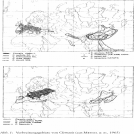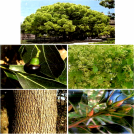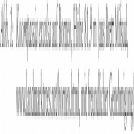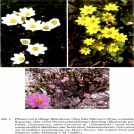botany
Zu den europäischen Arten der Ranunculaceen-Gattung Clematis L., Waldrebe
The European species of the Ranunculaceae genus Clematis L.
This text is based on the chapter entitled 'Clematis' from an unfinished book manuscript by Thomas Göbel. It was edited by Angelika Heinze for publication here as a single article. The European species of the genus Clematis are presented and organised into a series of… read more

Der Kampferbaum und die Lauraceen
The first part of this paper deals with the camphor tree (Cinnamomum camphora [L.] J. PRESL), a member of the Lauraceae family, and a source of the therapeutically significant etheric oil, camphor. This study addresses the question as to whether a thorough treatment of the therapeutic and toxic effects of camphor, as well as of the… read more

Vataireopsis amroba
Vataireopsis amroba. A plant for treating skin diseases
The wood of the tropical tree Vataireopsis araroba produces an exudate containing anthranoids (Goa powder, chrysarobin) which was used for topical treatment of psoriasis and other skin diseases. However, today it is larger obsolete and has been replaced by the synthetically… read more

Der Typus zwischen Irrationalität und Rationalität - oder: Das geheime Gesetz des Siebensterns (Trientalis europaea)
The ’typus’ between irrationality and rationality - or: the secret law of chickweed wintergreen (‘star-flower’, Trientalis europaea)
The theory of phyllotaxis, the positions of leaves on plants, describes the reciprocal 'annidation‘ of plant organs and thus the adaptation of the plant organism to itself so to speak. In this respect it… read more

Peripherie und Zentrum
Periphery and centre — indicators for inversions in plant growth
Goethe said 'that nature has no secrets that she does not somewhere present naked to the eyes of the attentive observer' (Annals of 1790). A secret in two senses, i.e. not only for our inspection but also for our understamling, is the changing shape of the organ in the… read more

Ranunculus lingua L., der Zungen-Hahnenfuß
Greater spearwort (Ranunculus lingua L.)
Ranunculus lingua L. is a member of the buttercup family. It has petioleless, lanceolate leaves and grows in water close to the bank and reaches a height of 1.5 m. Göbel (unpublished) and SUCHANTKE (2009) have shown that in the genus Ranunculus, with its multitude of leaf forms, the respective… read more

Knoten und Internodium
Nodes and internodes — on Goethe’s concept of the spiral tendency
Starting from the interesting phenomenon of biastrepsis (‘Zwangsdrehung’), the helical twisting of shoots, in which the rhythm of node and internode formation in the plant shoot deviates from a kind of continuum of both elements, we discuss the question of the eonditions… read more

Entwicklungsmorphologie eine typologische Betrachtung zur Formbildung
Evolutionary morphology a typological study of the development of form
The development of the inflorescence of Digitale lutea is described in detail from the formation of the primordium on the apex to the opening of the mature inflorescence and is documented by drawings of illuminated, complete preparations of the different… read more

Über das Verhalten des Blattgrundes an blütennahen Laubblättern der Gattungen Ranzmculus und Adonis Ranunculus bulbosus, Knolliger Hahnenfuß
On the behaviour of the leaf base of leaves in the vicinity to the blossoms of the genera Ranzmculus and Adonis
In the family Ranunculaceae we sometimes find transitional forms between the usually distinct leaf organs. The last leaves before the inflorescences in the leaf successions of Ranunculus acris (meadow buttercup), Ranzmculus… read more

Spuren des Chronos im Wurzelbereich
Traces of Chronos in the root region
Close investigation of rhythmic geniculation in root systems reveals cyclic processes of generation. Distinct roots repeatedly cease and are succeedecl by lateral ones. At a longer or shorter time before such a growth interruption takes place, the direction of growth changes more or less suddenly… read more

